In typical American style, marketing claims abound when it comes to our country’s pursuit of the best ghee.
You may have heard of grass-fed cow ghee, ghee butter, organic ghee, bulletproof ghee, paleo ghee, and so on. What do they all mean?
You may also be wondering if you should buy ghee that’s made in America (or local to you), versus ghee from India where the golden butter’s cultural roots are as ancient as it gets.

It might surprise you to learn that Indians have been through the same fear-of-fat dieting phase as we have.
And now that Indians have understood the healthful value of good fats (as we have), they are returning to genuine ghee, a traditional food in Indian culture, with renewed vigor.
Many Indians are also greatly encouraged by the fact that people outside India have discovered and are appreciating ghee.
To cater to this growing specialty market of ghee lovers both inside and outside of India, more than a few quality ghee companies based in India have started to cater to the export market.
This means there are plenty of excellent ghee brands from India available to Americans.
At the same time, Indian expats, as well as non-Indians who share a love for the culture, have started ghee companies based in the U.S that offer some very high quality ghee.
Top American Ghee Makers
Each U.S.-based company has unique selling points that appeal to American sensibilities, from bulletproof ghee to Gold Nugget Ghee (which, by the way, appears to be one of highest rated ghee products on Amazon with 284 five-star reviews.)
I have also noticed a lot of grass-fed, or pasture-raised ghee, which is a standard that aware consumers are looking for.
Here is a list of some of the top American ghee brands.
Bulletproof Ghee
Bulletproof ghee is one of the most famous among folks who love the namesake bulletproof coffee.
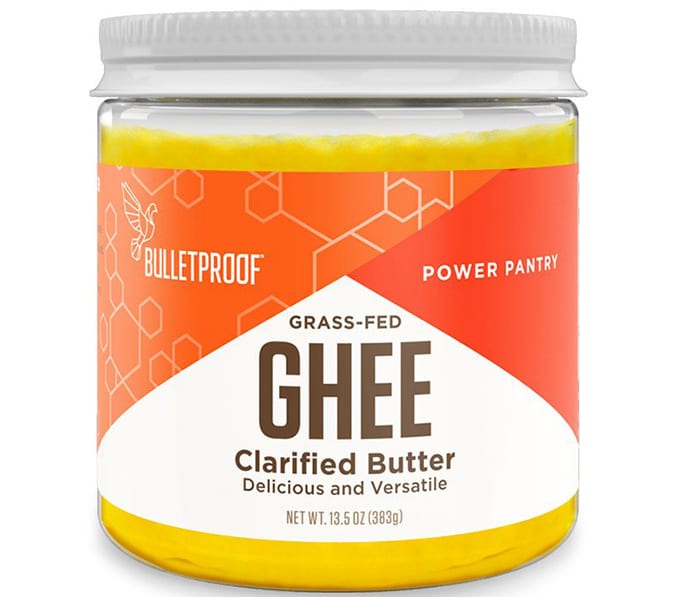
Bulletproof coffee is a drink invented by Dave Asprey, the founder of Bulletproof the company. It consists of a cup of freshly brewed coffee with 1-2 tablespoons of ghee blended into it.
Asprey got the idea while trekking in the mountains of Tibet, and tasting a cup of traditional yak butter tea. At the time, it gave him much needed energy and mental clarity. On returning home he invented bulletproof coffee, and it’s popularity has taken off in the U.S.
Adding high quality fat to coffee is suppose to provide a source of steady energy, and prevent the negative effects of caffeine crashes from drinking coffee alone. Many people swear by it.
Bulletproof ghee is made from grass-fed cow’s butter obtained from New Zealand. It is not one of the cheapest options on the market, but it has high reviews.
Companion products from Bulletproof enhance an active, high-performance lifestyle and a diet high in fats and low in carbs.
Bulletproof ghee is not special in and of itself, but this unique way of enjoying the ghee definitely is.
BUY BULLETPROOF GHEE
Gold Nugget Ghee
People seem to love the taste and texture of Gold Nugget Ghee, which is marketed to the paleo and keto communities of dieters who favor meat and high fat diets.
The ingredient label on this product says “organic butter (milk), cultures,” but there is no clarification (yet) on the process used to make the ghee.
Traditional ghee is made from cultured yogurt that is churned into butter and then heated to make ghee.
For me, when I look at this product, despite the cultures listed on the ingredient label, it is unclear how their ghee is made. This should be important to know.
As for their milk, the marketing claim on the glass jars says their cows are: “Full Year Pasture Raised.”
Then, on the company’s website, it says that their cows graze on the green grasses of northern California all year round. So it's local butter.
This could account for the beautiful, bright yellow color of this ghee. It does look beautiful.
It is definitely also worth plugging that Gold Nugget sells Goat Ghee, Yak Ghee (butter sourced from Mongolia), Mushroom Ghee, and Chocolate Ghee. These are all unique products on the market.
If you’ve tried any of these, please let me know in the comments below.
BUY GOLD NUGGET GHEE
Pure Indian Foods
New Jersey-based Pure Indian Foods appears to have the most authentic position in the American ghee market.
Husband and wife Sandeep and Nalini Agarwal are fifth generation ghee manufacturers from Northern India, who brought the business to the U.S. in 2008.
Nalini makes certified organic ghee by hand in stainless steel equipment, using milk from grass-fed cows. However, the company does not say where the organic milk comes from exactly.
The company does offer a genuine traditional cultured ghee made from milk that has been cultured into yogurt, churned into butter, and cooked into ghee. This particular product is certified lactose free.
This cultured ghee costs a few more dollars than their non-cultured ghee, and the company recommends it mainly for people who are seriously lactose intolerant.
Pure Indian Foods also makes a unique Turmeric Superghee, which is ghee cooked with turmeric root, ginger root, and black pepper.
This is the right spice combination to activate the healing properties of turmeric, according to studies.
If you want this company’s most popular product, it’s the classic 100% Organic Grass-Fed Ghee.
It comes in a 2-pack for $22.95, which is a good price on Amazon with over 1200 reviews with 4.5 stars on average.
If you are interested in checking this company out (and I recommend it), visit their website for a wonderful selection of organic grains, pulses, oils, accessories, and ghee, including Ayurvedic spiced ghee. Orders over $75 include free shipping.
Tin Star Foods Ghee
Tin Star ghee is a smaller player based out of Houston, Texas, but it’s doing a few unique things worth mentioning.
It offers a regular grass-fed ghee as well as a cultured ghee.
The cultured ghee is not made the traditional way using cultured yogurt. It is made from cultured Irish butter, which means that another company has done the culturing part.
However, by skipping a step Tin Star Foods is able to offer what is probably the least expensive lactose-free “cultured” ghee on the market.
They also have a cultured brown butter ghee, which I can only guess has been cooked longer so as to darken the milk solids.
People say it has a hint of maple flavor, or a nutty, buttery flavor. For me, this describes ghee itself!
BUY TIN STAR FOODS GHEE
Ghee For Lactose Intolerant Individuals
In the United States you can buy ghee that’s certified lactose-free. This means it is entirely safe for lactose intolerant individuals.
I haven’t seen such a certification from an Indian brand, however, if you buy a traditional ghee from India you can be almost certain that this is what you are getting.
This is because the process of making traditional ghee in India involves culturing milk into yogurt, or culturing the cream taken from the milk, into butter.
The final step is to heat the butter into ghee. The resultant product is healthier, with a richer, more complex taste than regular ghee.
Some people find that Indian ghee is smellier, and this is true. It comes from the culture.
During the fermentation process (culture), the offending lactose proteins are converted into lactic acid, making the product easier to digest.
You should know, though, that fortunately, all ghee is extremely low in lactose, which is already a bonus.
However, if you are highly sensitive to lactose, you definitely want to buy a cultured ghee, which can be guaranteed 100 percent lactose free.
Since culturing is the traditional way to make ghee, I believe the best ghee you can buy in America is cultured ghee.
From what I can tell, Pure Indian Foods is the only company offering a truly authentic product, and it is also organic.
Cultured ghee in America is what is known in India as traditional ghee, desi ghee, yogurt ghee, A-2 ghee, or vedic ghee.
Let’s talk about Indian ghee for a minute, because I think it has some very notable differences to offer the adventurous consumer.
In particular, Indian cows are different from American cows. They may produce better milk.
Know Your Milk
In my opinion, the key to sourcing the best ghee is to know the source of your milk.
The dairy industry in the United States isn’t the friendliest place for cows, or farmers.
Cows are bred specifically for bulk milk production, calves are weaned early, milking is done mechanically, and large numbers of cows may be kept together in tight quarters.
Of course there are differences from farm to farm.
Some dairies, especially smaller dairies, and some organic dairies in America, may operate with outstanding values and treat animals humanely. I would encourage you to seek these out.
See if you can find a single source dairy that’s local to you. This way you can get to know your dairy’s practices, and you’ll know what you are eating.
The U.S. brands I recommended above all use grass-fed dairy, and in the case of Pure Indian Foods, organic grass-fed dairy.
This is already pretty good, but Indian milk may just be even better.
Holy Cow That’s Good Milk
The Indian subcontinent boasts a unique breed of cows that produce a very high quality milk known as A2 milk. The cows are also regarded as holy.
Such cows are known as Gir cows, Hallikar cows, Ongole cows, or desi (Indian) cows. They thrive in the country’s mostly warm climate, as well as on the streets in major cities, villages, and everywhere.
An Indian cow can be identified by the big hump on its back, long horns, soft skin with glossy hair, and its affection for humans.
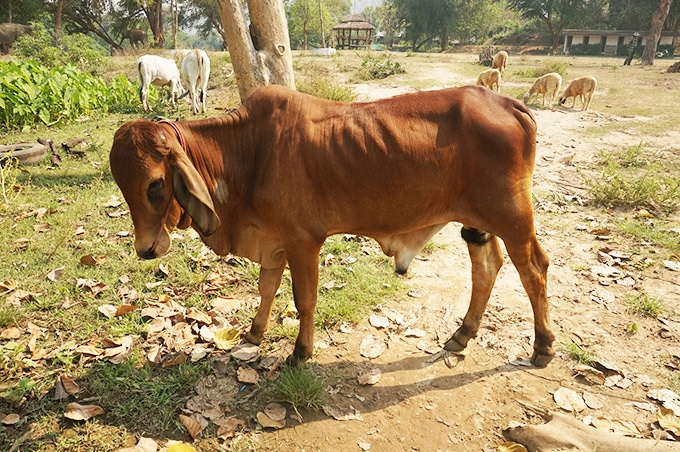
The love that Hindus in India have for their cows is well documented. As a Westerner on my first trip there, I came home with dozens of photos of cows pasturing on freeways and communing with passersby.
I have a theory that amid the chaos of India’s massive population and lack of developed infrastructure, cows are like bastions of peace. They move at their own pace, and their presence forces the world to slow down for them.
Hindus believe in ahimsa, or non-violence, and so Hindus don’t eat meat. Thirty-three percent of the population of India is vegetarian, and cows are generally protected from the fear of slaughter.
Hindus note that cows give freely of their milk much more than what is needed to nurse their young, so they revere the cow like a mother for her giving nature.
If all this holiness around the cow weren’t enough, the Indian cow’s characteristic hump has additional spiritual significance.
It is said that a surya (sun) vein runs through that hump, and that it transforms rays from the sun into medicinal “gold” salts in the animal’s blood and bodily fluids, which includes the milk.
Desi Cows Produce A2 Milk
Humped cows produce what is known as A2 milk.
A few recent studies have suggested that A2 milk is easier to digest that regular milk. It also contains more Omega-3 fatty acids than regular milk.
Most of the milk from modern cows in America, Australia, New Zealand, and Europe contains mostly A1 type proteins, whereas the A2 type is found in the older cow breeds of India and Africa.
American Jersey cows are a notable exception, as they, too, produce A2 milk. The type of protein is determined by the genetics of the animal.
By the way, A2 proteins are dominant in milk from camels, goats, donkeys, buffalo, yak, and sheep.
While the general availability of milk from these animals is reduced, those who have experienced it tout its taste and digestibility.
Should I Buy Indian Ghee?
After saying all this about the superior quality of Indian milk, you still must pay attention to the brand you buy, because you cannot assume that all Indian ghee comes from a reputable company.
There is a lot of fake ghee in the market that I talk about in my other article on ghee buying tips.
But as I said at the beginning of this post, there is an upsurge of pride in India about their traditional culture of the cow.
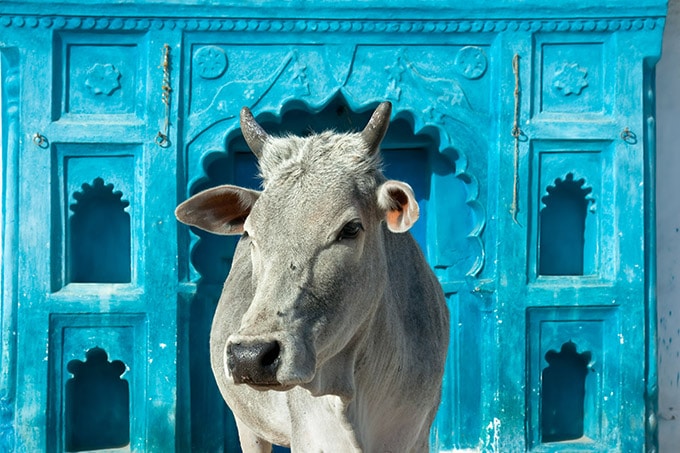
This has led to a number of excellent companies that combine a social mission with their businesses.
Their interest is in protecting their cow culture, along with the humane and traditional practices of dairying and ghee-making.
The certified organic industry is just getting started too, so you can actually buy organic desi ghee.
By the way, Indian cows eat grass all year round, and so grass-fed is not a term you are likely to find on a genuine ghee product from India. It is simply a given.
Recommended Indian Ghee Brands
Swaarnim Jain’s A2 Ghee
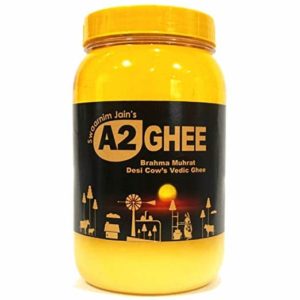
This product is a little pricey, at $50 for almost 34 ounces (1000 ml), but this is a large jar, and it qualifies for Amazon prime, which is a good perk.
The milk comes from Gir cows that are 100% grass fed, its A2, and this company is in the process of obtaining organic certification.
The ghee is made using the traditional method.
To be precise, their fresh morning milk is cultured into yogurt for 24 hours, and then bi-directionally churned to form sweet butter. The butter is then heated slowly and turned into ghee.
The main downside for this brand, (aside from the price), is that it is packaged in a food grade plastic jar, which some consumers don’t prefer.
BUY SWAARNIM JAIN'S A2 GHEE
Divine Ghee
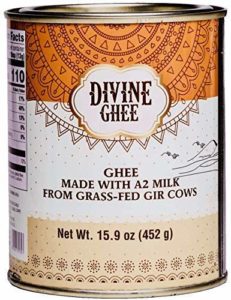
This is another Gir cow ghee from India, made from A2 milk. It costs $25 for 15.9 ounces.
Divine Ghee is made from cultured cream (rather than yogurt), which is churned into butter and then cooked into ghee.
According to the company, responding to a question on Amazon, their “Gir Cows are regarded as sacred, and treated with the utmost respect and care in the Gir region of India. They are completely free-range, grass-fed, and are hand-milked with no machinery or automated processes.”
Divine Ghee is packed in a stainless steel can with a food grade coating as per FDA regulations and is BPA free.
The company claims that this package protects their ghee from sunlight. It is also safer than glass for shipping from India.
BUY DIVINE GHEE
Shree Radhey Ghee
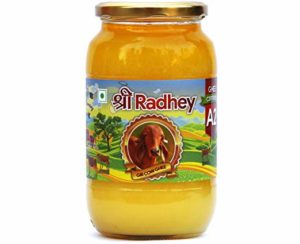
This is another Gir cow ghee, made the traditional way from cultured yogurt. It is $48.43 for almost 34 ounces (1000 ml). It is another large jar.
It is really interesting to note that this company claims to use dried wood and cow dung to cook the ghee. Very traditional indeed!
Buyers have noted that this ghee is a little whiter than usual.
The sellers say the cows are raised in a natural forest environment in the “serene areas of Holy Pushkar and are absolutely away from any cruel machinery.”
My guess is that this forest area isn’t as lush and green as normal, since green grass is what imparts a rich yellow color to milk.
This product is sold in a glass jar.
BUY SHREE RADHEY GHEE
Hanah Life Vechur Ghee
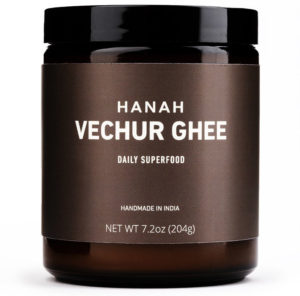
Hanah Life offers a very high quality artisanal ghee made the traditional way in small batches from milk that comes from a unique species of cows that live only in Kerela, South India.
The vechur cow is the smallest cattle breed in the world. They graze on mineral-rich lands that even contain Ayurvedic herbs, and have a unique ability to synthesize the grasses and herbs, which means their milk has a high medicinal content.
Only 300 of these cows remain in the world today, according to Hanah Life, and your purchase will aid in their conservation and survival.
I have tasted this ghee, and there is nothing like it in this world. Rich, nutty, heady, tasty, and incredibly healing is what comes to mind.
Shop at HANAH today. Free Shipping at $75.BUY VECHUR GHEE
Conclusion
I hope this post has been helpful for anyone in search of the best ghee, whether it be America made or Indian.
In my personal experience, there is nothing more amazing than ghee from India, particularly when in India.
It tastes authentic. It tastes amazing on my rice and dal, or with idli and dosa, especially when my mother-in-law serves it with such love.
What I am saying is that your choice of ghee will likely be a cultural one, based on your values and lifestyle.
Whatever you choose, I am confident in suggesting all the brands above, although I would favor options that use local milk in my choice of an American brand.
Any of the Indian brands are also very good, with the very traditional spirituality infused into the products, but then again these are imported and more expensive.
You may wonder which brand I use? While I have tried many, I actually prefer making my own ghee from organic butter.
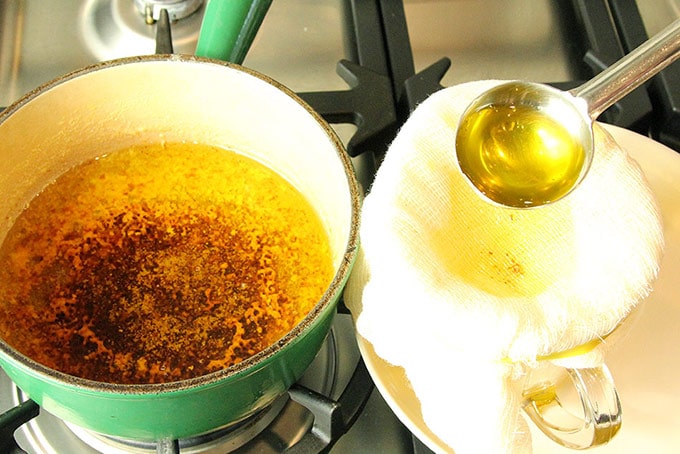
I love the process of making ghee and experiencing the smells and sounds. I love making extras and giving them to friends and family. I love making ghee with others too.
If you are interested in making ghee, you can see my ghee recipe for all the details.
I haven’t used cultured butter to make ghee yet, but I am going to try it next time and keep it for special occasions.
I wish you all the best on you journey of learning about and enjoying ghee.
It is a wonderful food that you can use in the place or butter or oil in any application. It is also safe for high heat cooking, and butter-tasty as can be.
Even my dad, who isn’t adventurous at all in food, enjoys ghee. If you haven’t yet, give some a try. You won’t be disappointed!
If you liked this post, please share it with your friends on social media, or leave a comment below.
For more Buttered Veg lifestyle content, follow me on Pinterest, Facebook, Instagram, and Twitter.
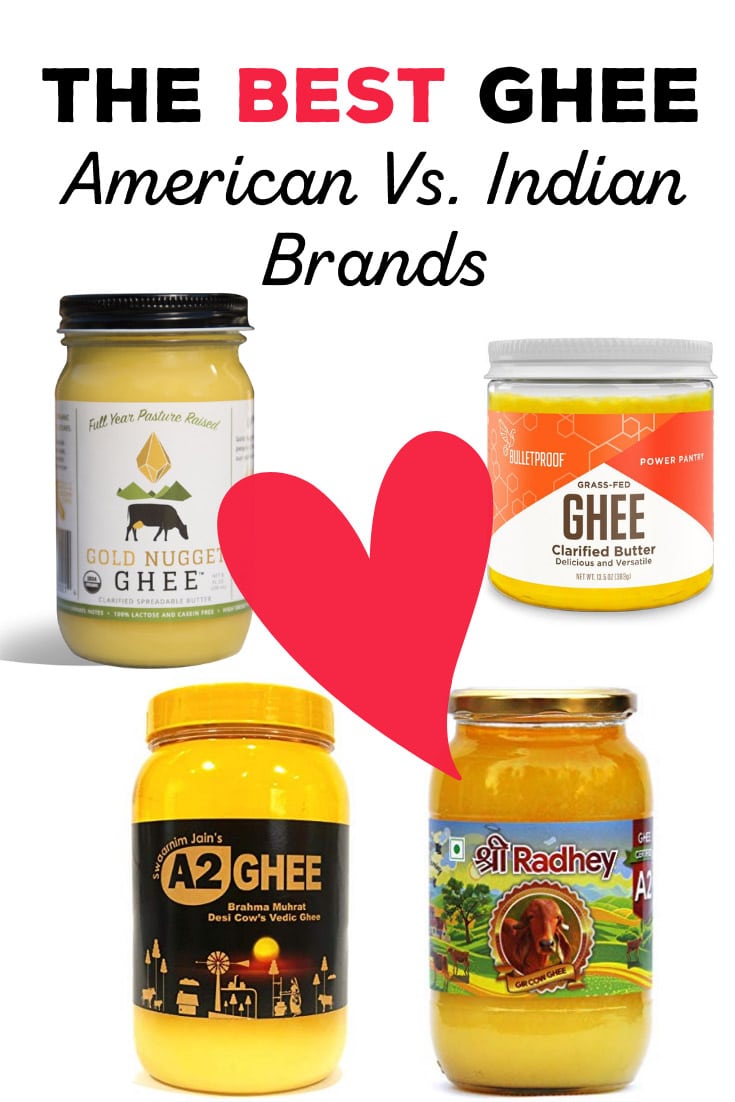

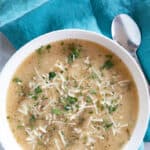
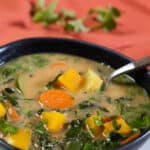
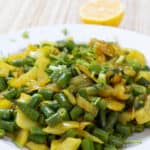
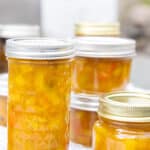
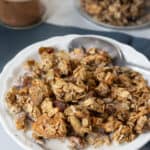
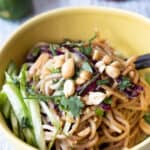

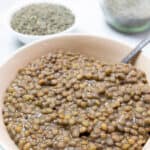
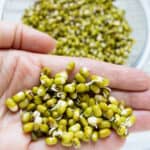
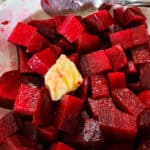


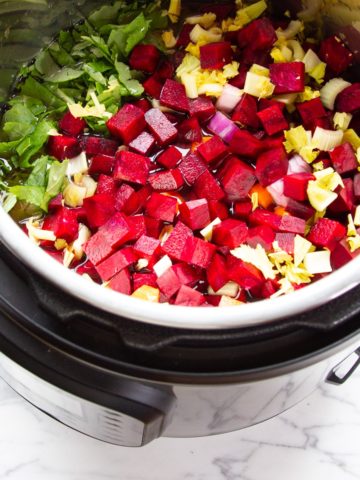
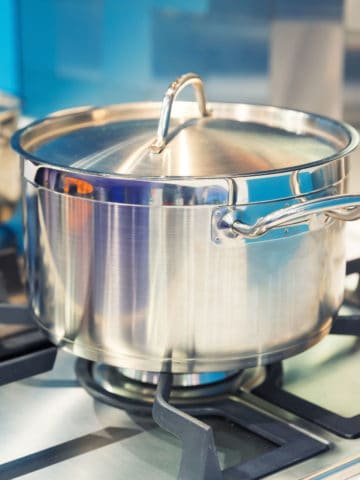
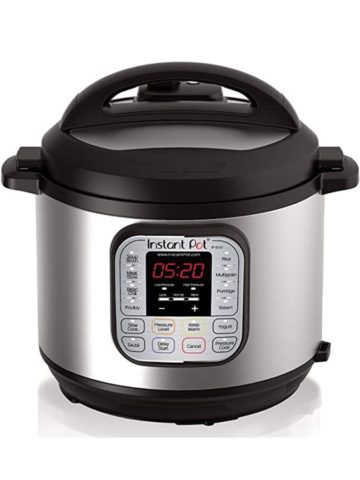
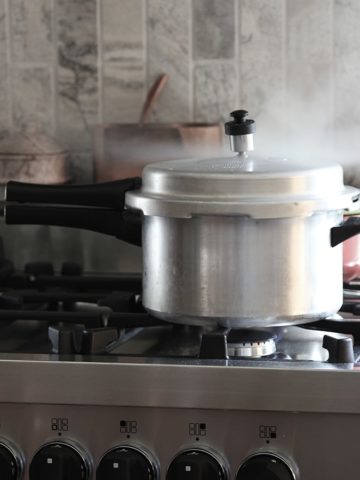
Swami Prem Dhan
Thank you for the ghee suggestions. I wonder which ones you would say take care of the cows well after they have stopped producing milk past their milking years. Thank you again and Regards.
Andrea
Thanks for the question. It is a good one, but I do not know the answer. We will have to contact them directly! When I find the answer I will post it.
Hema
Liked the information about ghee! I am a vegetarian (Indian kind) but lazy when comes to cooking. I will try your recommendations especially Indian ghee companies. BTW so far I have used Organic Valley ghee and been very happy with it. I didn't see any mention of it in your article.
Andrea
Thanks Hema, I will try Organic Valley. Organic Valley is a cooperative of family farms, and generally a good company.